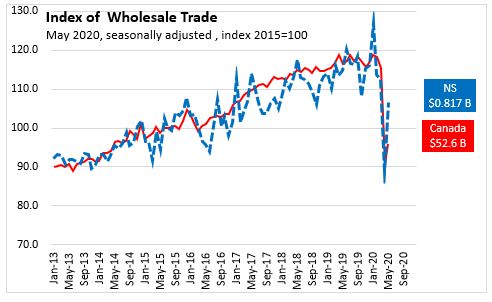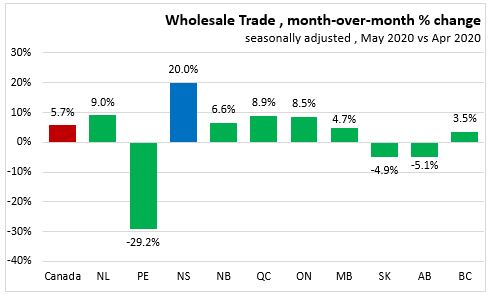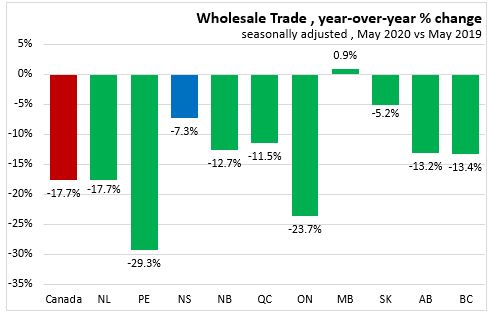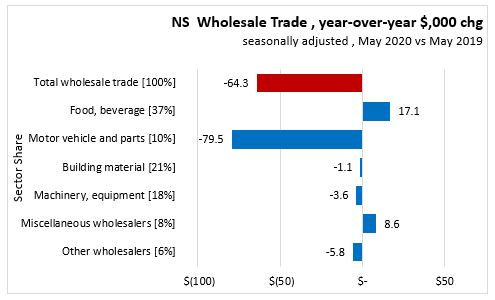The Economics and Statistics Division maintains archives of previous publications for accountability purposes, but makes no updates to keep these documents current with the latest data revisions from Statistics Canada. As a result, information in older documents may not be accurate. Please exercise caution when referring to older documents. For the latest information and historical data, please contact the individual listed to the right.
<--- Return to Archive
For additional information relating to this article, please contact:
July 17, 2020WHOLESALE TRADE, MAY 2020 MONTH-OVER-MONTH

In Nova Scotia May 2020, on a seasonally adjusted basis
- month-over-month Wholesale Trade increased 20.0 per cent $816.5 million over April 2020.
- year-over-year Wholesale Trade decreased 7.3 per cent over May 2019.
In Canada May 2020, on a seasonally adjusted basis
- month-over-month Wholesale Trade increased 5.7 per cent $52.6 billion over April 2020.
- year-over-year Wholesale Trade decreased 17.7 per cent over May 2019.
BY PROVINCE
On a month over month basis, seasonally adjusted Wholesale Trade was up 5.7 per cent nationally. Seven provinces reported monthly increases in wholesale trade, with Nova Scotia (20.0 per cent) reporting the largest gain in percentage terms. Prince Edward Island reported the largest decline (29.2 per cent) over the previous month.

On a year-over-year basis, seasonally adjusted Wholesale Trade was down 17.7 per cent nationally. One province reported a year-over-year increase in wholesale trade, Manitoba (+0.9 per cent) reporting the largest gain in percentage terms. Nova Scotia reported a decline (7.3 per cent) over the previous year. Compared to May 2019 Prince Edward Island reported the largest decline (29.3 per cent).

NOVA SCOTIA SECTORS
Year-Over-Year
Nova Scotia (May 2020 vs May 2019), Total wholesale trade year-over-year decreased 7.3 per cent ($64.3 million) over the same month last year.
- Food, beverage with a 37% share of Wholesale Trade increased 6.0 per cent ($17.1 million).
- Motor vehicle and parts with a 10% share decreased 48.4 per cent ($79.5 million).
- Building material with a 21% share decreased 0.7 per cent ($1.1 million).
- Machinery, equipment with a 18% share decreased 2.4 per cent ($3.6 million).
- Miscellaneous wholesalers with an 8% share increased 14.2 per cent ($8.6 million).
- Other wholesalers with a 6% share decreased 11.4 per cent ($5.8 million).

WHOLESALE INVENTORIES

“Inventories drawn down in May
Wholesale inventories declined 1.0% to $91.9 billion in May. Five of seven subsectors recorded decreases, accounting for about 73% of total wholesale inventories. The last time inventories fell more than 1.0% was in November 2017.
In dollar terms, the machinery, equipment and supplies subsector led the declines in May, down 3.2% to $26.5 billion as decreases were seen in all four industries. Roughly two-thirds of the subsector's decline was attributable to the construction, forestry, mining, and industrial machinery, equipment and supplies industry, down 4.5% to $12.4 billion in May.
After rising to a record 1.87 in April, the inventory-to-sales ratio dropped to 1.75 in May. Five of seven subsectors recorded decreases in their inventory-to-sales ratios, with the motor vehicle and motor vehicle parts and accessories subsector contributing the most.”
Statistics Canada
STATISTICS CANADA QUOTES
COVID-19 recovery and impacts
"After rising 1.7% in January to $65.1 billion, sales in the wholesale trade sector fell sharply as a result of the COVID-19 pandemic and the railway shutdowns... [Dispite ] increases in sales in May, COVID-19 [had a] large negative effect on [73% of ] wholesalers... Wholesalers estimated that COVID-19 caused a $16.5 billion drop in sales...."
"About 60% of the difference in sales between January and May came from the motor vehicles and motor vehicle parts subsector. Sales in this subsector rose in February, despite the rail blockades, but fell $8.6 billion in March and April combined.... [largely because manufacturers were] closed for all of April and parts of May [with little inventory for wholesalers to sell... Canadian motor vehicle manufacturing sales fell 97.8% in April and only partially recovered in May."
"The food and beverage subsector has not experienced the same size of shocks as other subsectors. Food, beverage and tobacco sales in May were only 2.1% lower than January sales… Food is traditionally less prone to economic shocks as the demand for food is largely stable.... In contrast, sales by food services and drinking places fell 58.6% from February to April."
Reference Tables
20-10-0074-01 Seasonally adjusted Wholesale sales by province
20-10-0074-01 Nova Scotia seasonally adjusted Wholesale trade by NAICS sectors
20-10-0076-01 Canada seasonally adjusted Wholesale Trade Inventory
Citations
Statistics Canada. Table 20-10-0074-01 Wholesale trade, sales (x 1,000)
Statistics Canada. Table 20-10-0076-01 Wholesale Trade Inventories (x 1,000)
<--- Return to Archive